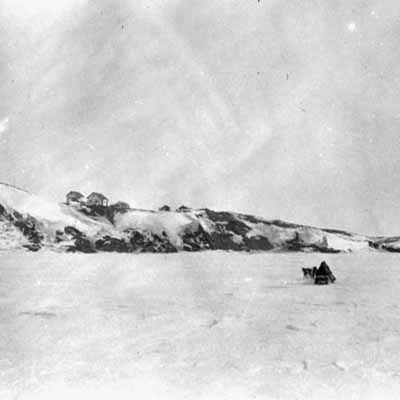Kittigazuit Archaeological Sites National Historic Site of Canada
Kittigazuit, Northwest Territories

General view
(© Library and Archives Canada/Bibliothèque et Archives Canada, Department of Indian and Northern Affairs/Ministère d'Affaires indiennes et du Nord Canada, 1932.)
Address :
Kittigazuit, Northwest Territories
Recognition Statute:
Historic Sites and Monuments Act (R.S.C., 1985, c. H-4)
Designation Date:
1978-06-19
Dates:
-
1400 to 1900
(Construction)
-
1400 to 1900
(Significant)
Event, Person, Organization:
-
Inuit
(Person)
-
Hudson’s Bay Company
(Organization)
Other Name(s):
-
Kittigazuit Archaeological Sites
(Designation Name)
Research Report Number:
1978-SUA, 2007-SDC-028
Description of Historic Place
Kittigazuit Archaeological Sites National Historic Site of Canada is located on the island of Kittigazuit at the mouth of the Mackenzie River in the Northwest Territories. The site, set in and around the present-day village of Kitigaaryuk, encompasses a number of archaeological features, including the ruins of winter houses, a collapsed log cabin and ice house and remains from the old village of Kittigazuit. On the high ground to the north and south of the village, a number of traditional graves are visible by their marker stones. Official recognition refers to an irregular polygon around the archaeological site.
Heritage Value
Kittigazuit Archaeological Sites was designated as a national historic site of Canada in 1978 because: occupied continuously during the period 1400 to circa 1900, it was the location of the largest seasonal gathering of Inuit known in the Canadian Arctic; for at least 500 years, it was used as a beluga hunting station by the Kitigaaryungmiut, the ancestors of today's occupants of Inuvik and Tuktoyuktuk.
The heritage value of Kittigazuit Archaeological Sites lies in its historical associations with the Inuit populations who used the site for beluga whale hunting, as illustrated by the site and its archaeological remains. Archaeological evidence shows that the Kittegaryumiut have occupied Kittigazuit continuously for over 500 years, between 1400 and 1900. The site was used for summer beluga whale hunting by Inuvialuit populations living in the area, who took advantage of the estuary as a natural trap for the whales. Approximately 1000 people used Kittigazuit and the neighbouring village of Kupuk during the summer months, making it the largest traditional Inuit community known in Arctic Canada. Remains of six large winter houses and the number of traditional aboriginal graves are still visible today. The site is also the place where Sir John Richardson, a member of Sir John Franklin’s second Arctic expedition, first met the Inuit. Additionally, it was the location of the first Hudson’s Bay Company trading post operated on the western Arctic coast. The remains of a log house and ice house used by the Hudson’s Bay Company are still visible.
Sources: Historic Sites and Monuments Board of Canada, Minutes, June 1978; December 2007.
Character-Defining Elements
Key elements that contribute to the heritage character of the site include: its location in and around the village of Kittigazuit, at the mouth of the Mackenzie River in the Northwest Territories; its setting on a rocky island separated from the mainland by a narrow channel; the integrity of any surviving or as yet unidentified archaeological remains relating to the Inuit occupation, including the visible remains of six winter houses, large cruciform-shaped houses, graves and their marker stones, cache pits, midden deposits, beluga whale skeletal parts, and other anthropogenic features of unknown function; the integrity of any surviving or as yet unidentified archaeological remains relating to the Hudson Bay Company’s trading post, including the remains of the collapsed log cabin, ice house, and the company store; the viewscapes from the site across the Mackenzie River.